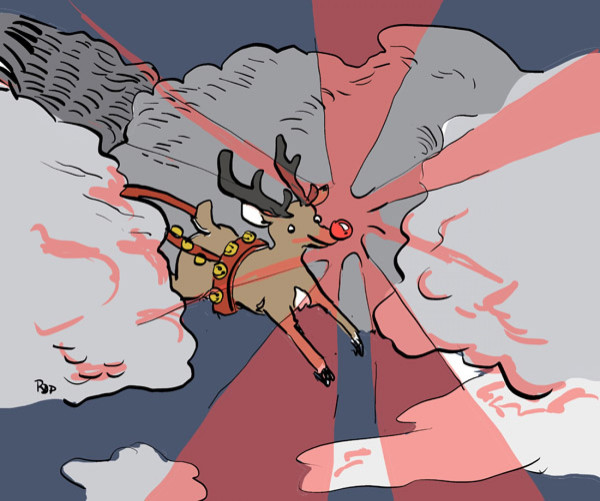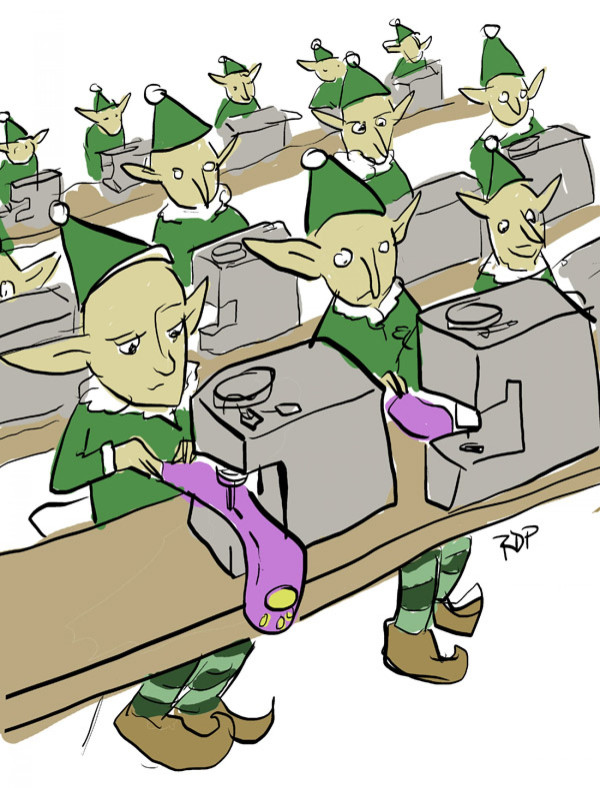Santa Science: Fact Checking Saint Nick's Christmas Ride, Rudolph's Nose And Elf Labor Abuse [ILLUSTRATIONS]
You may want to send the kids out of the room before reading this article: Our (highly informal) scientific and economic investigation shows just how physically impossible Santa Claus’ yearly journey is -- and how inhumane his labor practices are.
But first, the good news:

Putting aside the issue that scientists have yet to discover a species of flying reindeer, at least one part of the Santa myth checks out: Rudolph’s nose is actually pretty well-suited to guide the big guy’s sleigh through the clouds. Red light has the longest wavelength of all visible light, and is much less prone to scattering in our atmosphere. If Rudolph had had a purple nose -- purple being on the short end of the spectrum, wavelength-wise -- Santa would be out of luck.
But when we consider the logistics of one man visiting all the Christmas-celebrating households in the world, things start to look a little difficult for our red-suited Saint Nick.
Santa Claus Is Hurtling Through Town

Just how many houses will Santa have to visit in one night? Taking the estimated world population of 7.1 billion (from the Population Reference Bureau) and subtracting people of faiths that typically don’t celebrate Christmas (around 3.1 billion Muslims, Jews, Hindus and Buddhists, according to the CIA Factbook), you get an estimated 3.9 billion Christmas celebrants. About 26 percent of the world’s population is under 15, so that gives you about 1 billion children expecting presents. And going by the average global fertility rate of 2.5 kids per woman, we can estimate that Santa has to hit around 400 million households in one night.
Luckily, Santa has a little more than 24 hours to work with -- thanks to the vast spread of time zones across the planet, any given calendar date will usually last for about 50 hours on Earth. But even then, he’d have to go at a blistering pace to make 2,200 visits per second.
Assuming that each trip between households is about 0.1 miles, in that second Santa makes those 2,200 visits, he travels 220 miles, or just under 800,000 miles an hour -- about 1,000 times the speed of sound (767 miles per hour).
It’s safe to say that at that speed, without any kind of magical buffer, Santa and his reindeer would be quickly vaporized.

Maybe wormholes are a better solution.
Serious Holiday Weight Gain

Even if Santa manages to visit all those houses and make it through in one piece, he’ll probably suffer some major ill effects from eating all those cookies left for him. If he eats just two Pillsbury sugar cookies (120 calories, 6 grams of fat) at every house, that adds up to about 48 billion calories and 2.4 billion grams of fat. If we take the usual estimate of 3,500 calories in a pound, Santa would gain a little more than 13,714,285 pounds.

That would make it awfully hard for him to fit in the average American chimney, which is about 12 inches across.
Coal In The Stocking -- Not Necessarily a Bad Thing!
But of course, Santa won't be bringing toys for everyone. Just how many bad kids will get a lump of coal? The juvenile arrest rate in the U.S. in 2010 was 225 per 100,000 youths; if we extrapolate from that, about 10,000 kids made Santa's naughty list. If each of those kids got a 1.6 ounce lump of coal, that'd be 1,000 pounds of coal, enough to generate 900 kilowatt-hours of electricity, almost enough to power the average American home for one month.
Exploited Elves
Setting aside the improbability of Santa’s journey, we now turn to the sheer injustice of Father Christmas’s labor practices. Though most stories make mention of Santa’s hardworking elves, no one ever mentions just how much Santa’s workers are compensated.

Let’s assume every child is getting a teddy bear for Christmas. The crew at the Vermont Teddy Bear Company makes about 750 bears a day, and employs more than 270 people. Assuming for our purposes that every single person is involved in making bears, that’s about three bears a day per person. At that rate of bear production, Santa would have to have about 900,000 elves working 365 days a year to make 1 billion bears for Christmas.
Canada just recently laid claim to the North Pole, so we can only assume that Santa must be legally required to pay the minimum wage rate of its northernmost territory, Nunavut, which is C$11.00 per hour, or $10.30 per hour in U.S. dollars. If each elf works just eight hours a day (with no bonuses for working on weekends and holidays), they’re entitled to a yearly salary of just around $30,000, meaning Santa’s labor costs alone are going to be about $27 billion (around the total costs of the Manhattan project).

Considering that Santa has been operating for centuries (since about the 300s, if you start with the historical Saint Nicholas), those are going to be some serious back wages he owes if the elves manage to organize.
Note: We were inspired in part by this humorous Santa investigation posted at spunk.org (and published in Spy Magazine), but the calculations (and, as follows, any errors or assumptions) are our own. The piece has sparked a number of rebuttals and nerdy Christmas arguments throughout the years.
© Copyright IBTimes 2025. All rights reserved.





















